Tactical Theory: Rest-Attack
The term rest-defense, translated from the German “Restverteidigung”, has become more known (and utilized) in recent years. Its equivalent on the other hand, is still rarely talked and even less (consciously) used in coaching, though more frequently by players on an unconscious level.
In order to explain rest-attack, we will shortly utilize a brief explanation of rest-defense and mirror it from there. Basically, rest-defense is a catch-all term to describe the part of a possession phase where some players can’t contribute to the attack anymore and, depending on the possibility of a turnover judged through pressure on the ball, adapt their positioning already in possession in order to prepare for defending a possible counter.
Although it was not as popular in the mainstream nor as thoroughly used in coaching, “balance” or “coverage” has been known for since the start of the game (probably). Some more pronounced definitions have been used, with further categorization in the German landscape (and coaching education) of the “rest-defense” as the preparation of defending whilst in possession from the last line of the attacking team, the “rest-field-coverage” being used for the coverage of the “development players” in between the last line and towards the ball, with the players in immediate access to the ball and surrounding it doing their share of defending by “counterpressing”.
If this categorization based on spaces surrounding the ball reminds you of either the Barcelona-rooted Positional Play™ or the German pressing school, you’d probably be right with either as in both the ball is in the center of everything that happens in the game. Which, you know, just makes sense.
Still, “rest-defense” for the players further away from the ball and counterpressing for the players nearer to the ball is what’s widely used nowadays for their respective tasks prior or at the moment of a defensive transition. This also makes sense as in terms of the chronology of the game, counter-pressing starts the latest (with the transition moment being the turnover of the ball itself) in regards to preparation but the earliest in regards to activation (with the rest-defense being possibly compensated by the counterpress) and it, on a team level, being two different tasks whereas “rest-field-coverage” is basically “rest-defense” just slightly higher up the pitch towards a different set of players.
Yet, something that is less talked about and is, perhaps, even happening more naturally on a player level, is the preparation of a counter. Guardiola’s famous quotes about how a team’s positional play also defines their possibilities prior, at or after the moment of a turnover can be applied similarly for the other game phase. This applies for the other game phase in the same manner: A team’s defending style defines their possibilities prior, at and after the moment of a ball recovery. These phases of the game stay interconnected in the other direction, too. Again, we can use the ball as first and most important reference in order to create guidelines for coaches and players.
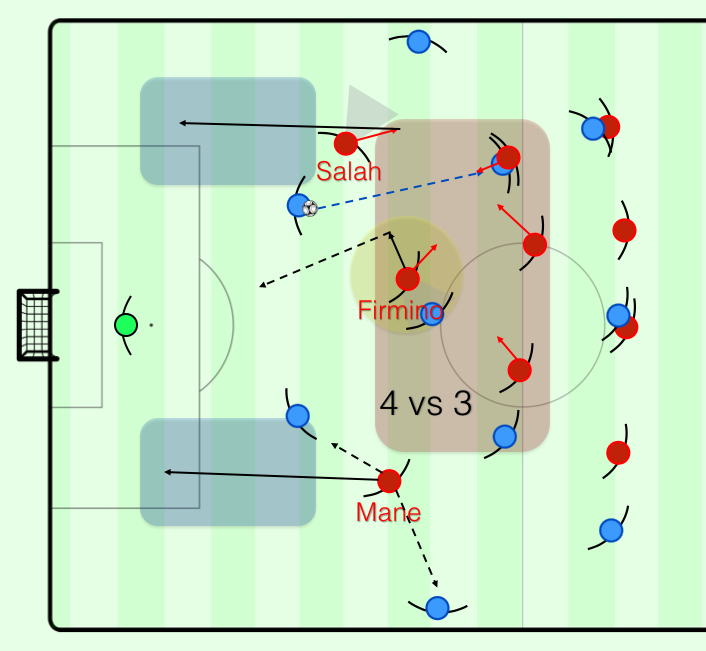
When does the transition between game phases actually start?
Internally at Spielverlagerung, we already had quite some discussions about the transition phase. Although not necessarily an opinion that everyone shares, there still seems to be an agreement upon transition being a moment instead of a phase with the transition moment on a team level being the turnover of possession, but on an individual level connected to the tasks in relation to the possible turnover and its subsequent consequences. Going away from these more academic discussions, a philosophical question emerges: When does the transition (or defending/attacking phase after the transition moment) actually start in terms of it happening?
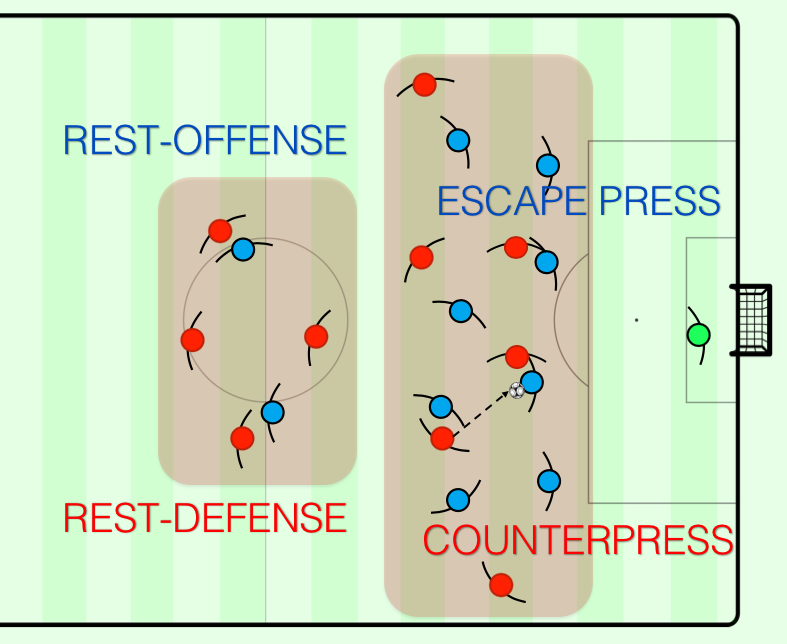
While the turnover of the ball is a somewhat clear and common event, it is also the consequence of the situation before. If you are positioned badly around the ball or as a team in general, the possibility of a turnover is enhanced and, arguably, the turnover is already starting. If there is pressure added to it, then the probability is further enhanced and the process of the turnover is already quite advanced.
It is in these circumstances – realizing the positional inferiority of the opposition, coupled with adequate pressure on and around the ball – where the transition (for both teams) should be starting already. The attacking team already has to adapt to the situation by either trying to get out of the mess with the players that can help to do so and the other players, who are not a possibly relevant part of the attack anymore, preparing the defense (rest-defense).
This applies for the defending team, too. The players around the ball have to finish the ball-recovery with every mean necessary, but the others – not playing a role for the recovery itself anymore – can already prepare for the attacking post-transition.
On a team level, transition will really start with the moment of the turnover. On an individual level, especially in top level football, these transition moments might occur in a different moment before, but ideally as near to the transition itself as possible – either instantaneously when the loss of the ball is a foregone conclusion for the counterpressing players and minimally before this conclusion arises for the attacking players who cannot change the situation anymore moving into rest-defending. This should be true for (rest-)attacking also. By moving into desirable positions when the recovery of the ball is a “foregone conclusion”, the ensuing counter will be both easier and more dangerous.
Around the ball: Finish defending!
There is a small lopsided relationship between defending and attacking in football. The ideal outcome of attacking is to score and, thus, not having to defend. This is, quite obviously, preferred to counterpressing. The ideal outcome of defending is not only not to concede a goal, but ideally to win the ball in order to solve the problem of the other team attacking and having the ball to prevent them from continuing so and also to, again quite obviously, try to score yourself. Yet, both ideal outcomes lead to a turnover – in attack it’s a static one (the kick-off of the opposition) and in defending it’s a dynamic one (continuation of play).
The players around the ball have first to win the ball and then to find a path out of that particular mess which is the defending situation itself. The first pass out of (counter-)pressure is decisive. If you are too far or too tight, you’ll lose momentum in your counter. Playing too narrowly leads to (successful) continuation of counterpress by the opposition. Playing too far leads (mostly) to a worse situation for the counter. Very often coaches use guidelines to either make the first pass or carry out of pressure, before then a carry or a pass into farther, more open space can be done.
In a perfect turnover situation, the recovery will already be an interception (ball-recovering player has less pressure and more open vision of the field) or a tackle where the ball is pushed (or even passed) directly to a team mate with a field of vision towards the forward line / opposing goal. A diagonal pass is preferred to a vertical one forwards which is in turn preferred to a vertical backwards and, probably, similarly to a square pass on average – depending on if the square pass then can progress further or not.
This nature of the ball recovery itself is a very important point. A player intercepting a pass will often have less immediate pressure, more field of vision towards the opposing goal and the chance to decide between a dribble or a pass. A player winning the ball by tackling should usually get rid of it by a very quick pass or survive the counterpressure by a very good dribbling. Favre’s Gladbach, for instance, barely prepared their counters or had any group-tactical patterns, but still was very decisive and dangerous because they would often have clean recoveries, a clear setup for the transition and enough space to utilize the qualities of their players.
Besides the nature of the ball recovery itself, there are other components which factor in:
- The higher a team wins the ball, the nearer the player will be to the opposing goal, but at times he will be finishing without team mates.
- The earlier a team wins the ball, the less organised the oppositional cover will be, but at times the spaces will also be smaller.
- The more centrally a team wins the ball, the shorter is the path to the opposing goal, yet the angles will often be worse.
- The faster a team wins the ball, the faster it can attack the opposing goal with less opposition, but at times also with harder technical execution.
Obviously, player profiles do play a role, too. If Camavinga or Modric intercept a pass, the counter might look slightly different to one of the authors being the ball carrier in transition.
Near the ball: Movement for the ball recovery
Depending on the nature of the ball recovery and the positioning of the opposing players, the players around the ball should immediately open up in order to become able to escape out of pressure and progress the ball further. If their defending team mate is tackling the ball, they should join him in the duel and then use the tackle or push of the ball as a pass into space to turn and look to find open space out of the opposing counterpressure.
If the defending team mate has intercepted a pass, they should spread and move up in the highest possible speed, in order to give him more time to carry the ball or, if an opponent steps out, to have a short advantage for a one-two or to receive in space. Nevertheless, in both situations early, immediate and fast movement out of organized defending positions is key to have a quicker transition than the opposition and, thus, beat them out of their counterpress.
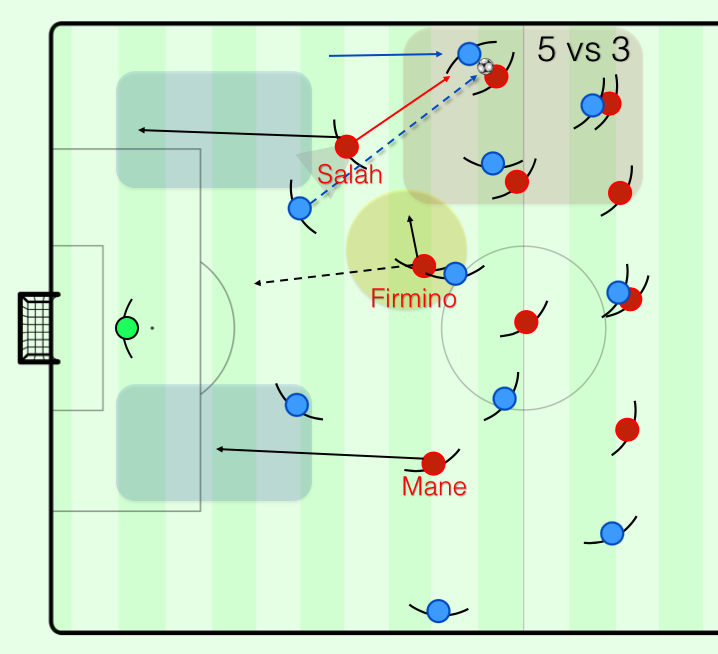
Until the ball is won, such movements might actually be risky to the defending and harmful to win the ball. The players should look to join the ball recovery and finish defending the attack with then, just like in counterpressure, find the right (and earliest useful) moment to open up and find the right decision to escape out of counterpressure by passing, dribbling or even just moving into open space where they can receive without pressure. Diagonal movements away from the ball towards the opposing goal while checking the shoulder for opponents seems a useful guideline in coaching.
Further from the ball: Position for the ball recovery
Whereas the players near the ball barely can adapt their position, but have to use the timing and speed of their movement relative to the transition moment, players further away from the ball can “gamble” a bit more and change their position even earlier than the transition. This, mostly, is what would be defined as “rest-attack”; the positioning of defending players who are already preparing for the attack, which in this case is a counter.
Two general situations can be considered (regardless of game-state or more specific adaptations to some opponents): If the attack progresses on one side and the other side will probably not be involved anymore in the attack, then the defending players on the other side who will probably not have any defending function anymore (i.e. the winger, but rarely the full back) might gamble and stay or move higher even while the attack of the opponent is yet to be stopped as the opponent on his side might have to abandon joining the attack (thus, the risk of not defending actively anymore is mitigated by having a defending function) or he might join the attack fruitlessly and risk to concede a much more dangerous attack on the other side. In reality, a lot of these gambles happen but rarely planned and very often without a real benefit for either side.
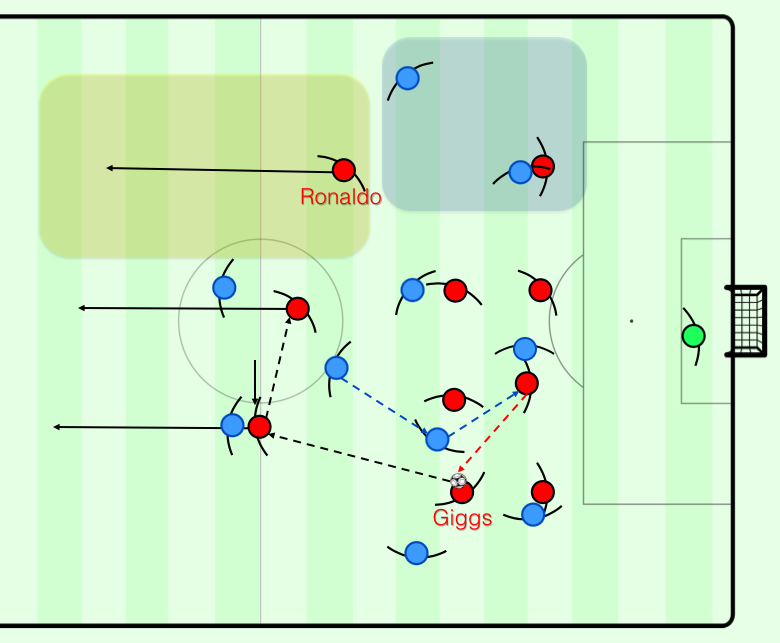
The other situation is that the ball is not on the other side, but the ball is far away and finding a function for team defending will not be possible anymore, so the only chance to still become beneficial for the team is by preparing a possible counter now. Hereby, players can start to roam around or look for spaces where they can get found in open space on the counter or at least influence some of the opponents’ decision to join the attack or cancel and stay deeper – or lure out opposing defenders and open space for other “defenders” without function who are preparing for the rest attack.
In both situations, similar to rest-defending, the positioning can start early and should try to move out of opposing access into connectable positions or open more valuable spaces deeper on; this can be done before the counter is starting and/or the movement starting with the ball turning over at the latest, towards the opposing goal in the highest speed.
Optimizing the structure
As mentioned previously, the positions one fills when defending influence the possibilities in transition. If we try to define some basic roles that entail the most important function in this specific situation, there are some possibilities to identify it like a picture in the moment the transition starts and how the starting positions from the defensive organization enable or disable specific actions.
- Wide Runners/Carriers – Those who fill the lanes outside the defence. A guiding principle for their positioning is to be as wide as needed to be able to receive the ball facing forwards, but as narrow as possible to enable bypassing an opponent with the first touch, switches without losing momentum and generally to attack the goal as directly as possible. These roles are typically filled by wingers, but often in two striker systems, one or both can be done by a striker peeling wide from a narrow position.
- Binder – A lone striker in a counter is rarely the ball carrier, and usually only late in the counter an option to receive. Yet the position can open various possibilities through pinning two centre backs by staying between them, threatening the space behind and attacking it as soon as one of the centre backs decides to engage the ball carrier.
- Connector – Often a player starting in the central lane giving a good starting position to move out where needed, to open dribbling paths, be an option for a quick combination or even to give depth and/or create a 2v1 on the opposite side to the 9 in the final moments of a counter.
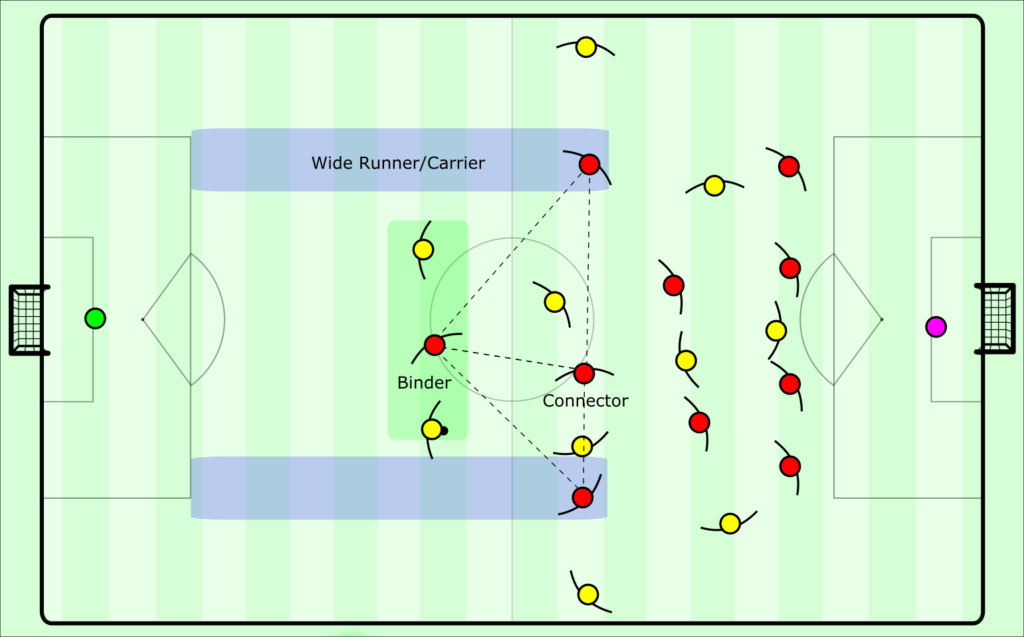
In counters with 2 players, both will usually fill the wide roles to ensure, if necessary, passes can be made with the receiver facing forwards. Binding here would make little sense without width on either side to exploit it, thus any runs made from wide into a narrower position would be solely to receive in behind. With a third player in the counter the binding role is often filled, enabling both extra space for the wide players to carry and a narrower receiving position by tying the defenders to cover the depth. The connector role is a possibility in 3 player counters, yet most effective with four where the other possible functions are occupied.
Specifically, the defending formation at the moment of ball recovery, rather than the planned defending formation, will influence how many of these functions can be filled and how quickly. Formations with 3 or more players positioned to support an attack quickly have more potential for quicker filling of different functions and thus more direct counters. Whilst formations with only two, such as 4-4-2 or 5-3-2, rely on long support runs from an 8, wide midfielder or WB in the second phase of the counter to fill a third function and allow a more varied counter attack.
With a lone striker and wingers either side, the wingers are often afforded a higher position by the extra cover in the midfield or defensive line. This along with the central striker enable 3 player counters with wide runners and a binder to be formed extremely quickly, and are key features of counters from 4-3-3/5-4-1 recovery formations. In two striker set-ups with a central 10, the close connections between the 3 allow very direct progression and flexibility in which players fill which function. Both strikers can simply fill wide runner functions if the 10 is the main carrier, while the 10 can fill the binding or wide runner role if one of the strikers are the carrier. Two strikers without a 10 however, rely on long support runs from an 8, WB or wide midfielder in the second phase of the counter to fill a third function and allow a more varied counter attack.
In 4-2-3-1 however, you have the highest number of players positioned to quickly support a counter, with the most efficient spacing for quick filling of functions. Or, said differently, 4-2-3-1 has the best rest-attacking structure. Along with the typical binder with wide runners on either side structure of a 4-3-3, the 10 immediately behind adds a potential ball carrier allowing all three to focus on giving depth. With the binder forcing narrow positions from the opponents’ defenders, and wide runners on either side the 10 has more options for passes into open space than in other formations.

Other things to consider
Obviously, on the level of application all these theoretical aspects might change and differ depending on player roles, club culture or other things like a preferred set of pressing traps which lead to counters. Even things like training “counterpassing”, using the concept of “Restfieldspread” to mirror the latest trend in German coaching education for “rest-field-coverage” could be useful.
Why is it so intriguing?
Rest-attack seems a very powerful concept in modern football for many different reasons. Obviously, the athletic capability of players has reached a level where they are actually able to finish a transition after working to create it. They reached a cognitive capability where they are actually able to recognize the situation where they can prepare the counter while the team is technically still defending. Modern attacking and defending schemes have reached a higher average level than ever before, teams becoming more similar in their fundamentals, which seems to tighten the gap between individually similar teams.
In turn, counters on open space seem to be on average easier (i.e. more promising) than positional attacks on more closed, condensed space. Most positional attacks break down sooner than later, leading to less quality shots, if at all, and tend to be a consistent, frequent test of the settled opposing defense. Counters on the other hand tend to break down later than sooner in their development (if they get developed though), lead to higher quality shots while being less cost-expensive in terms of player resources needed. This relates to the amount of players to finish the attack but at times also due to tactical and technical issues. In regular defending, teams often can cope without defending optimally, but just well enough. In counters, this bar is raised.
This, in turn, logically seems to lead to a potentially interesting gamble. For good examples, look at Belgium versus Brazil in 2018, Gladbach in their first season under Rose, Cristiano Ronaldo as an individual over the years, Leverkusen under Seoane and Salzburg under Jaissle right now. Note: Everything ever written in tactical theory articles applies on a general level to men’s and women’s football, no matter the age or level.
2 Kommentare Alle anzeigen
Simon July 11, 2022 um 7:08 pm
Thanks for the article. I like the mirroring with (frequent) rest-defence and the different rolls in the structure.
Can you tell me how i can find your concept of the field and the players? I love the clear concept and bodymovements.
badbeatbob July 2, 2022 um 12:00 pm
I enjoyed your article very much, as you said rest attack is less talked about, so it’s good to see that you explained it in great detail. I have a question about rest defense. You mention it a lot of times, that moving into rest defending positions should be a bit before the turnover. In my opinion optimizing rest defense isn’t about a moment, you should keep the attackers under controll and also the spaces behind your defensive line during the whole posession, of course according the place of the ball and the phase of your build up. What’s your opinion on this?